
18 minute read
EXHIBITIONS INSTALLATIONS
DAKOTA MODERN: The Art of Oscar Howe
OCTOBER 29, 2022 – MAY 14, 2023
BY KATHLEEN ASH-MILBY, CURATOR OF NATIVE AMERICAN ART
When the Dakota artist Oscar Howe passed away in 1983, he had become a legend among Native artists as much for his paintings as his bold strike against the gatekeepers of Native American art in the mid-20th century. A student of both Dakota artistic traditions and modernism, he created artwork steeped in cultural knowledge but expressed in a distinctly dynamic approach. Despite what was arguably conventional subject matter, the vivid abstract forms and dynamic motion in Howe’s paintings were unsettling to some who were more comfortable with the tranquil and nostalgic approach to Native American painting that had been largely established in the early 20th century by students of the Santa Fe Indian School and painters working in Oklahoma. After one of Howe’s paintings was rejected from competition by the jurors for the Philbrook Museum of Art’s annual Indian painting exhibition in 1958, he fired off a passionate letter to the museum including the withering words, “Who ever said that my paintings are not in the traditional Indian style has poor knowledge of Indian art indeed.” His advocacy also included establishing a summer workshop for Native American students at the University of South Dakota, which he led for nearly 20 years, to encourage them to pursue a university education and career in the arts.
While Oscar Howe’s stature as the “grandfather” of contemporary Native American art has lived on, he was never recognized widely for his achievements and, until Dakota Modern: The Art of Oscar Howe debuted in New York this past spring, was all but unknown in the larger art world. This exhibition seeks to secure his legacy as an important mid-century artist and American modernist, expanding the recognition of modernism beyond the elite circle of artists recognized in the canons of American art and global modernism. While newcomers to Howe’s work will be immediately taken with his expressive yet fastidiously detailed paintings— which New Yorker art critic Peter Schjeldahl described as “power-packed compositions” with “aggressive hues” and the “channelling of sheer, visionary imagination”—the exhibition will also give viewers insight into his development and tools for understanding the content of his work.
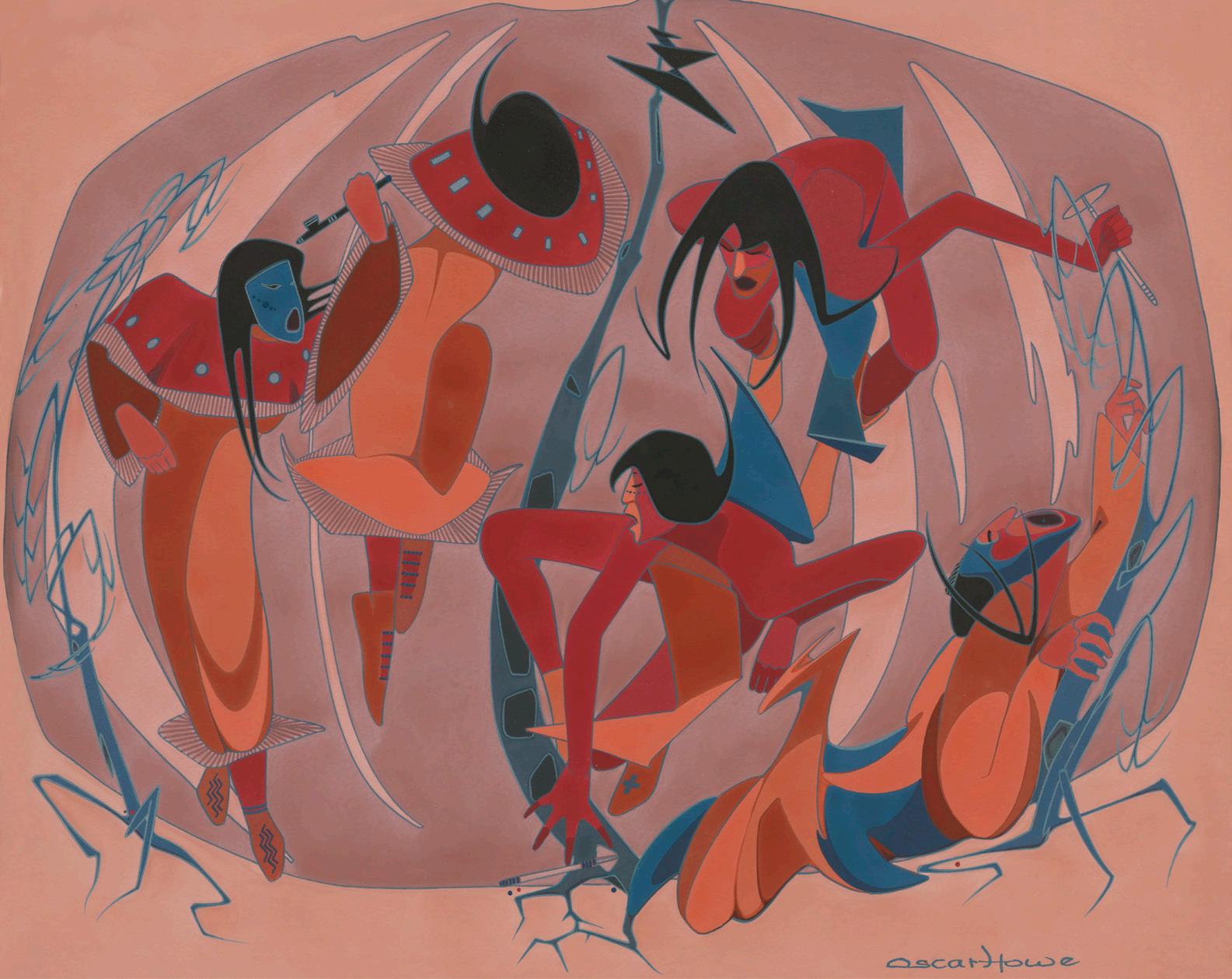
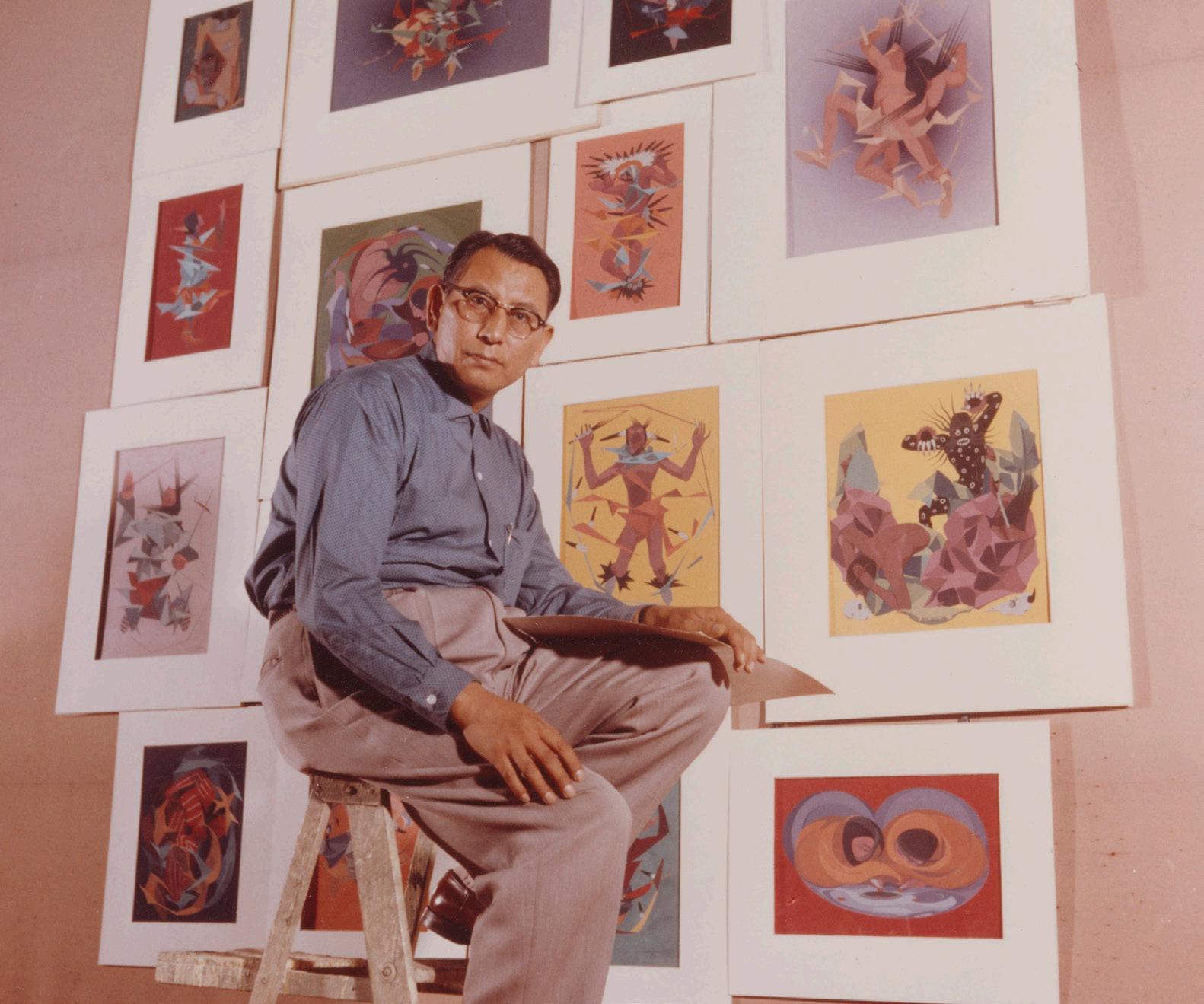
After an initial introduction to some of Howe’s most dynamic compositions, viewers will begin the exhibition with his earliest student work from the 1930s, including several paintings, such as the serene Blue Antelope, which show the stylistic and cultural influences that came to define a movement known as “Studio Style” or Traditional American Indian Painting in the 20th century. His development rapidly advanced between these early years and his work in the 1940s and 1950s, as his approach was informed by experiences as a WPA artist and his art degrees earned at Dakota Wesleyan and the University of Oklahoma. As the viewer moves through the exhibition which focuses largely on his mature work in the late 1950s and 1960s, they will learn about the content of Howe’s work as a storyteller who depicted Dakota and Lakota creation stories, cultural figures, and practices, as well as his technique and masterful use of line and color. The exhibition concludes with a gallery film focused on his biography, including his connection to popular culture through his decades-long work as a mural designer for the “Corn Palace” in Mitchell, South Dakota, and his appearance on the television show This Is Your Life, hosted by actor Vincent Price. We hope our audiences here in Portland will find Oscar Howe’s work both beautiful and inspiring, leaving the exhibition with a deeper appreciation for this American master whose legacy of innovation and advocacy will continue to inspire generations. An extensive, multiauthored catalog is available for those who want to know even more about Oscar Howe’s life and art.
Organized by the Smithsonian’s National Museum of the American Indian and the Portland Art Museum. Curated by Kathleen Ash-Milby. Major support provided by the Henry Luce Foundation. Additional support provided by the Wyeth Foundation for American Art. Support for the Portland Art Museum installation provided by the Institute for Museum and Library Services, grant MA249741-OMS-21, Ameriprise Financial, The Standard, Greg and Cathy Tibbles, The Boeing Company, the Ed Cauduro Fund of the Oregon Community Foundation, Joe and Cathleen Karcher, Lani McGregor and Daniel Schwoerer, and Wells Fargo Foundation.
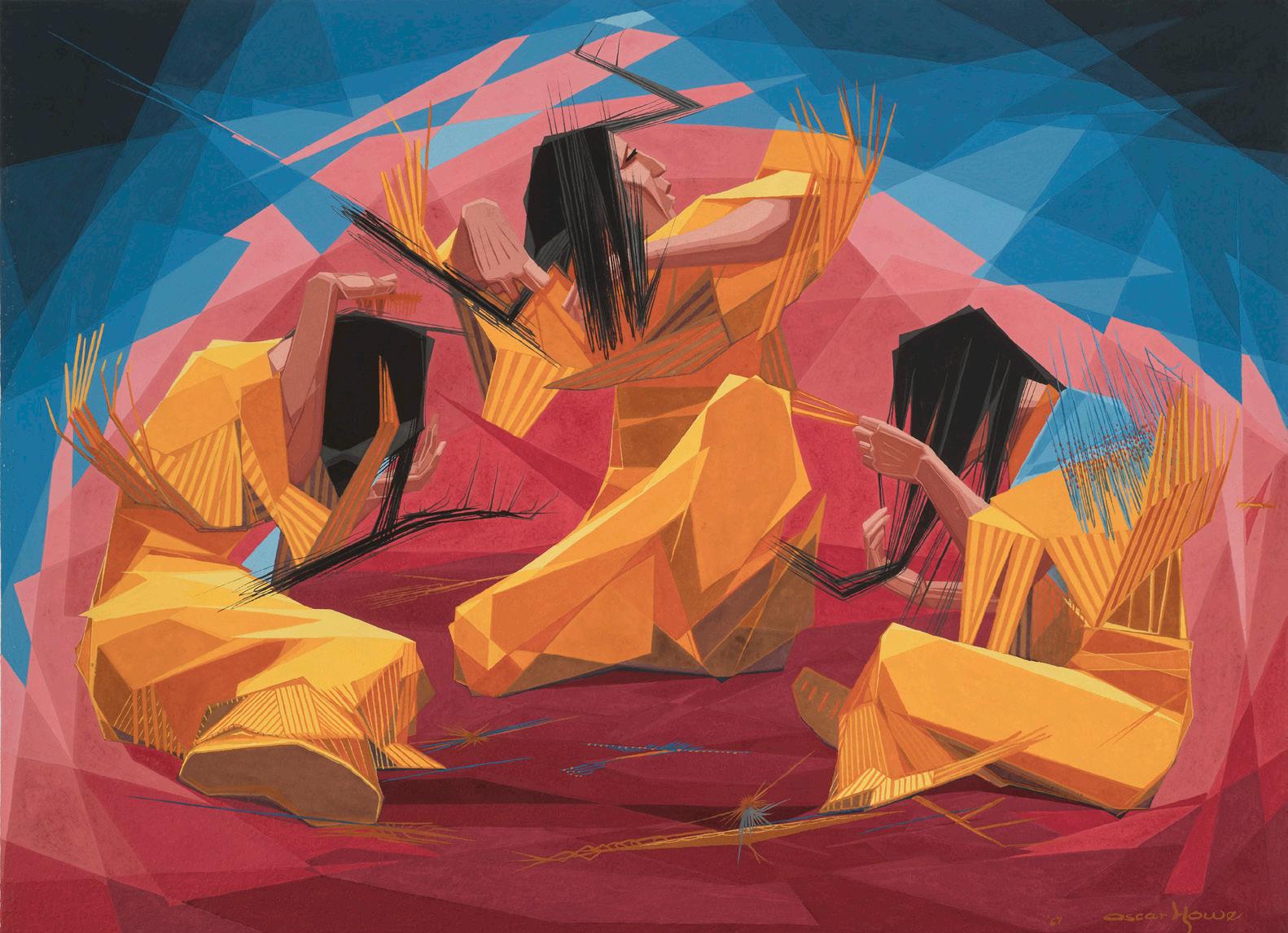
Team Howe:
PANEL DISCUSSION
SUNDAY, OCTOBER 30, 2022, 2 P.M.
WHITSELL AUDITORIUM
Join exhibition curator Kathleen Ash-Milby, and colleagues who contributed to the exhibition and publication of Dakota Modern: The Art of Oscar Howe, including Bill Anthes (Pitzer College), John Lukavic (Denver Art Museum) and Christina Burke (Philbook Museum of Art), for a lively discussion about the development of this project.
Voices Like Thunder:
AN AFTERNOON OF POETRY WITH THE NATIVE ARTS AND CULTURES FOUNDATION
SUNDAY, NOVEMBER 6, 2022, 2–4 P.M.
PORTLAND ART MUSEUM, FIELDS BALLROOM, 1119 SW PARK AVE.
This event is a partnership between the Portland Art Museum and the Native Arts and Cultures Foundation in conjunction with the exhibitions Jeffrey Gibson: They Come From Fire and Dakota Modern: The Art of Oscar Howe. This event has been developed through fostered community partnerships and is part of the Portland Book Festival Cover to Cover Program 2022.
Symposium: Oscar Howe
FRIDAY–SATURDAY, APRIL 14–15, 2023
In this two-day event of lectures, panels and gatherings, scholars, curators, writers, and artists share their research and thinking about the life and work of Oscar Howe, in honor of his contributions to the contemporary Native American art field. We invite the public to join us for a keynote lecture by contemporary artist and curator Dyani White Hawk on April 14. Tickets required. For ticket information visit portlandartmuseum.org.
JEFFREY GIBSON: They Come From Fire
OCTOBER 15, 2022 – FEBRUARY 26, 2023
BY KATHLEEN ASH-MILBY, CURATOR OF NATIVE AMERICAN ART
Anticipation has been building for the siteresponsive exhibition They Come From Fire by Jeffrey Gibson, opening this October at the Portland Art Museum. Gibson, who is a member of the Mississippi Band Choctaw and of Cherokee descent, is one of the preeminent Native artists working today. He began his career primarily as a painter over 20 years ago, but has expanded his practice into sculpture, mixed media, installation, video, and public art. We invited Gibson, who is known for his adventurous use of materials, brightly hued geometric abstraction, and social commentary, to create an installation that would be in dialogue with a concurrent exhibition by the mid-century Dakota painter Oscar Howe. Although they come from very different generations, there is a synergy between these two artists who share a passion for both abstraction and vibrant color as well as cultural affirmation and celebration. As a Native artist who has forged his own path while remaining true to his artistic heritage, Gibson embodies Howe’s lifetime of advocacy for Native art, as well as his nurturing of the next generation of artists as an educator for most of his career.
Visitors will begin to experience They Come From Fire when they approach the building and encounter Gibson’s graphic designs on the museum’s facade windows, which will be filled with color. Sixty of the window panes will foreground Indigenous history in Portland, creating a timeline from 1805 to the present that reflects well-known historical events interwoven with personal milestones sourced from our diverse Portland community. The centerpiece of his exhibition will be 12 glass panels suspended in the Museum’s interior Schnitzer Sculpture Court, each emblazoned with a statement of power and resilience such as “They Protect the Land” and “Our Bodies, Our Rules.” The rectangular format and messages echo protest posters, both defiant and bold, touching on recent events in Portland and a wider societal acknowledgement of the presence of Native people and history. For Gibson, an important goal of this project is to foreground the local, multi-tribal Indigenous, BIPOC, and LGBTQ+ communities, many of whom will be featured in black-and-white portraits taken earlier this year on top of the empty monument pedestals in the Park Blocks. The choice to engage with the empty monument pedestals was purposeful; pedestals are meant to venerate and honor. By placing

Indigenous and other community members literally “on a pedestal,” Gibson is reinscribing these contested sites of strife with positivity and new meanings. To further challenge the use of the pedestals, Gibson asked participants in the project to come as they wanted to be seen rather than directing their appearance to send any particular message. Several brought keepsakes from deceased family members or other items central to their identity such as music or posters. Some wore traditional regalia and others regular street clothes. The subjects include individuals, families and friends, children and elders, and groups such as the 7 Waters Canoe Family.

Light will be projected through the glass panels, washing these portraits with a rainbow of color. Together, the timeline, glass works, and portraits will combine to create a powerful representation of our diverse Native community. Organized by the Portland Art Museum and curated by Kathleen Ash-Milby, Curator of Native American Art. Support provided by the Institute for Museum and Library Services, grant MA-249741-OMS-21, The Broad Foundation, the National Endowment for the Arts, Ameriprise Financial, Sikkema Jenkins & Co, Greg and Cathy Tibbles, and the Jordan Schnitzer Family Foundation.
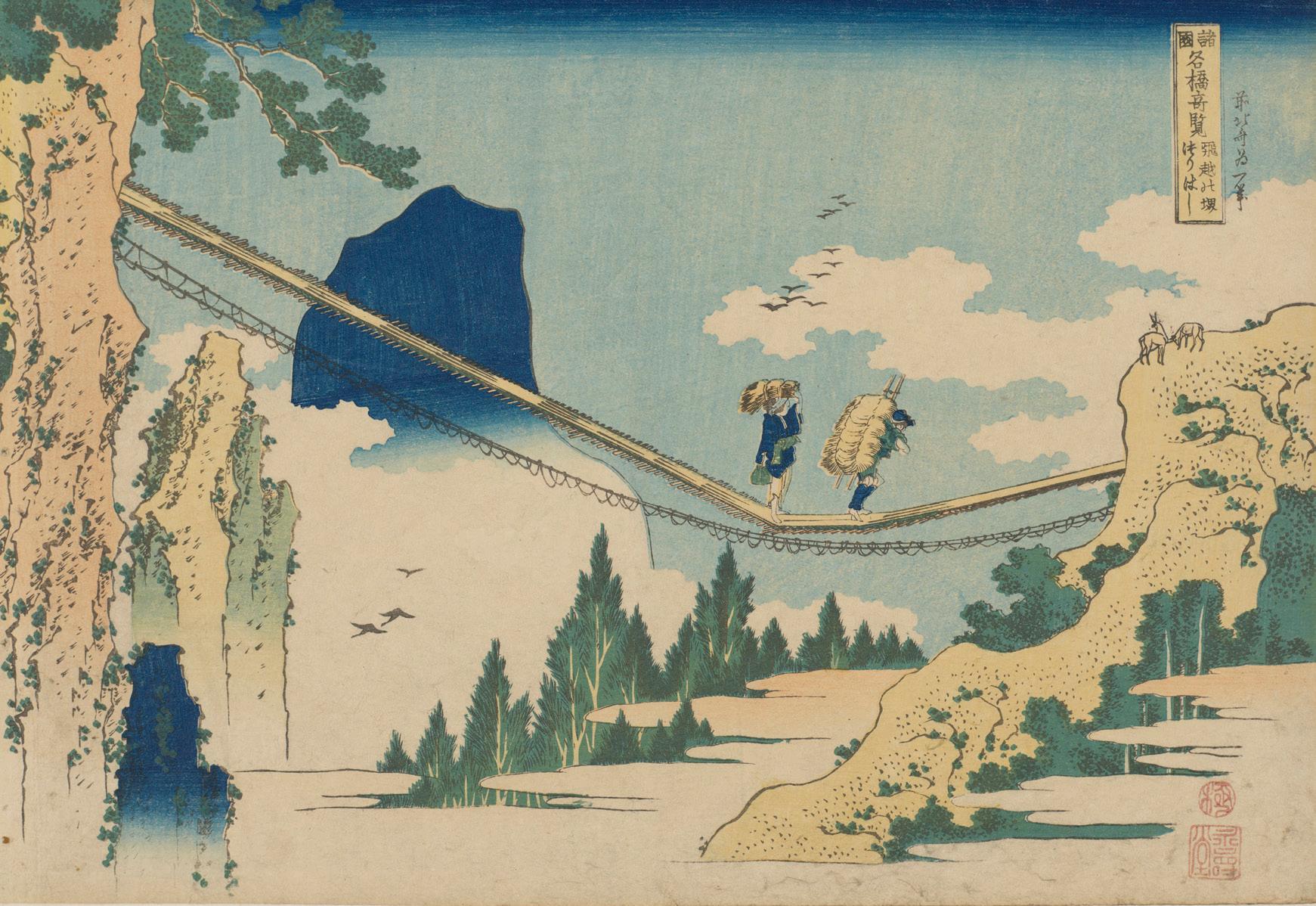
HUMAN | NATURE:
150 Years of Japanese Landscape Prints
OPENS DECEMBER 3, 2022
Through the lens of landscape prints, this exhibition explores Japan’s journey with and through nature during the 19th century and into the modern age, revealing the reverential, familiar, and playful spirit in which people held the trees, mountains, and rivers around them.
World-renowned print artists Katsushika Hokusai (1760–1849) and Utagawa Hiroshige (1797–1858) mirrored and molded people’s relationship with nature, inviting them to roam remote mountain passes interspersed with vertiginous waterfalls, or reflect on the lyrical beauty of legendary meisho (famous places). These artists show us how nature can awe and inspire, as in Hokusai’s magisterial tribute to Japan’s most revered peak, the Thirty-six Views of Mt. Fuji. Hiroshige’s snapshots of urban flora and fauna in the series One Hundred Famous Views of Edo also capture how nature charms and surprises as it insinuates itself into city life. Later woodblock prints reveal that landscape continued to play a pivotal role in the lives and identity of Japanese people into the 20th century. Nature wreaked havoc on human life in the Great Kantō Earthquake of 1923, as dramatically visualized in prints by Nishizawa Tekiho (1889–1965) and his colleagues, but it also offered sites of enduring cultural memory and solace in a hectic modern age. This exhibition will draw upon highlights of the permanent collection to visualize just some of the many ways in which the human-nature relationship has unfolded in Japan. A selection of prints by American and Japanese artists working in the Pacific Northwest, including Gordon Gilkey (1912–2000) and Sekino Jun’ichirō (1914–1988), will also be showcased in this exhibition, suggesting how the human affinity for nature transcends time and place and resonates with us here and now in Portland. Organized by the Portland Art Museum and curated by Helen Swift, The Japan Foundation Assistant Curator of Japanese Art. Support provided by the Japan Foundation.

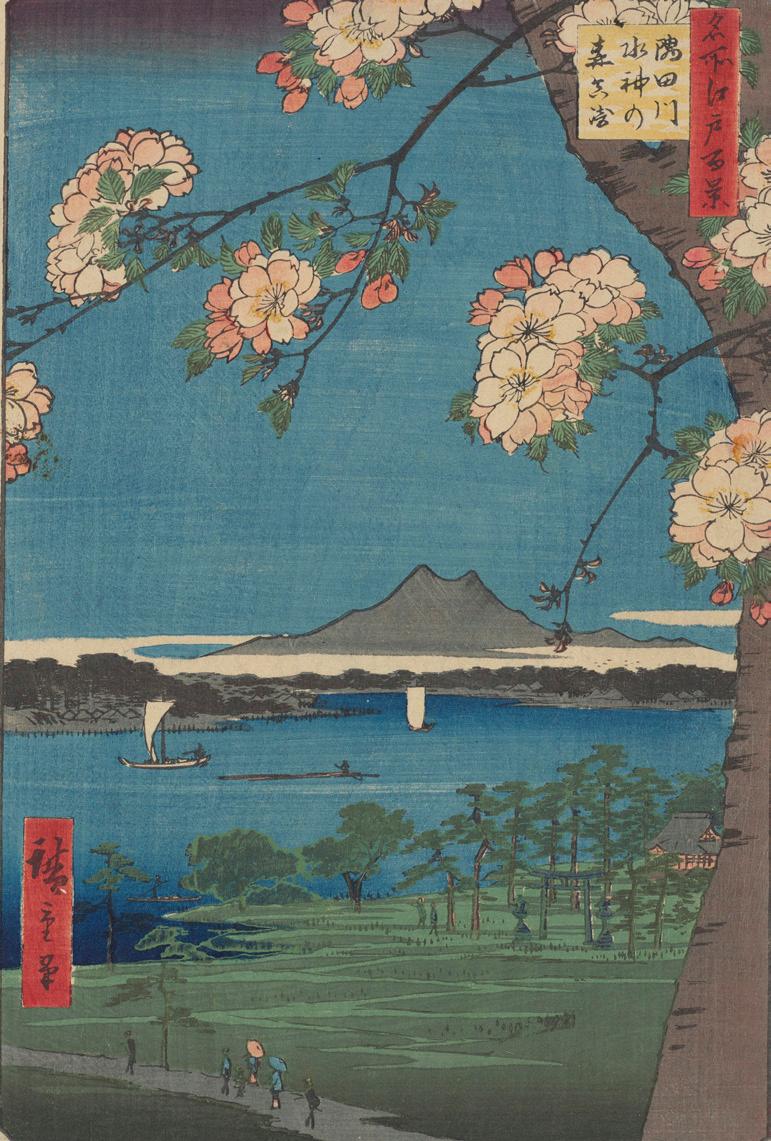
TRACES
THROUGH APRIL 23, 2023
Now on view in the Jubitz Center for Modern and Contemporary Art, Traces presents poetic reflections on memory in contemporary art. Art has long played a role in aiding memory by depicting detailed stories through history painting, epic poems, or song cycles. It is also a space for artists to give physical forms to cerebral or emotional sensations. This exhibition, featuring recent acquisitions alongside artworks borrowed from private collections, showcases seven international artists who evocatively capture the traces of events, people, or places, as remembrances of real experiences or projections of imagined ones.
Works by three artists reflect upon how memory, experience, and place intertwine. In Unsettled (Jerusalem), Cornelia Parker gathered discarded pieces of wood from the streets of that Middle Eastern city. Suspended together to hover just above the gallery floor, these simple objects conjure thoughts of the region's conflict as well as feelings of society’s precarity. In her Reconstructions series of prints, Huma Bhabha draws on top of photographs of architecture and landscape that she took on a visit to her home country of Pakistan. Her gestures suggest the layers of subjective memories that shape perceptions of shared public spaces. Theaster Gates uses roofing materials like tar, bitumen, copper nails, and wood to connect the trade learned from his father to his pursuit of abstract painting. Anne Chu, Nohemí Pérez, and Maja Ruznic depict the figure and each uniquely attests to the way memories are indelibly centered on human action and our perceptions of each other. As a refugee from the war in the former Yugoslavia, Ruznic draws on personal and collective memories of this trauma to convey hidden, or buried, aspects of the psyche. Ruznic likens her painting process to emerging from a dream: thin layers of oil paint reveal ghostly figures and as shapes bleed into each other, borders between human, nature, and memory symbolically also dissolve. Tatiana Trouvé explores memory’s fallibility in two large drawings that consider the sense of loss when memory fails. As she explains, “I try to leave things open to a form of disorientation and the possibility of navigation. I am more sensitive to the physical and mental wavering that the works can produce than I am attentive to a position from which they should be seen or understood in this or that way.” Curated by Sara Krajewski, the Robert and Mercedes Eichholz Senior Curator of Modern and Contemporary Art. Supported in part by Exhibition Series Sponsors. ONLINE: Visit our website to learn more about Nohemí Pérez’s Palmar series, from which three powerful works were recently acquired for the Museum’s collection with generous acquisition support from the Northern Trust Purchase Prize, Sharon and Keith Barnes, Mary and Don Blair, Diane and Herb Rankin, and Pat and Trudy Ritz.


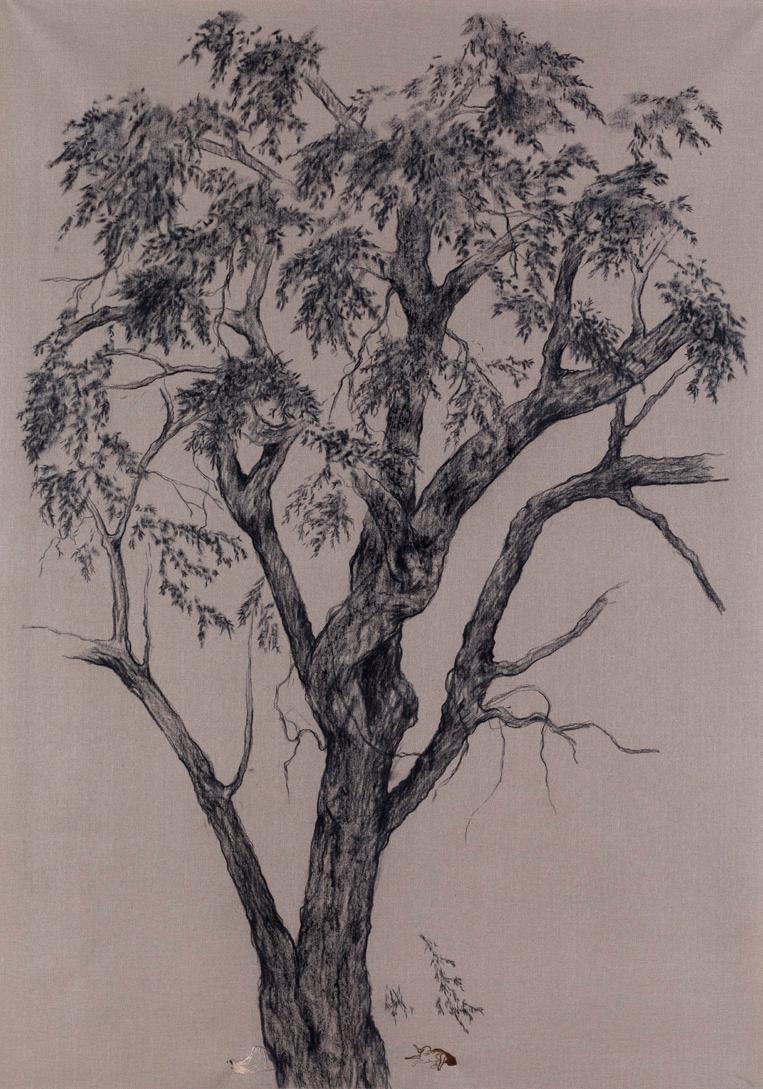
OTIS QUAICOE:
(s)kin deep
THROUGH DECEMBER 31, 2022
Since Otis Quaicoe’s move from Accra, Ghana, to Portland in 2017, his figural paintings have adjusted and shifted in congruence with a heightened cultural awareness of his relocated body. As he looked at Blackness and race in American society from the perspective of an African immigrant, Quaicoe became more interested in depicting the nuances of skin tone that emerge in velvety grayscale. In common with artists like Robert Pruitt and Amy Sherald, Quaicoe chooses as models real people with whom he finds connections. This small body of work reflects Quaicoe’s interest in these individuals through portraits, studying not only the skin but the colors and expressions of identity through clothing. Quaicoe’s paintings offer rich, impasto textures in backgrounds and skies that reflect the stucco walls of traditional Ghanaian homes.
Man in Red Beret and Invisible both reflect the ease of the subjects and the playful fashion expressions while the different contours of the skin provide a sculptural presence. In the untitled drawings of the two women, expression and individuality are illustrated through their dramatic hairstyles. For Quaicoe, Ouncie Mitchell is the artist’s representation of a real and imagined Black cowboy, set against the vast blue where the crown of the cowboy hat nearly fades into the bright sky. Quaicoe’s portraits do not just invoke identity of the painful bonds tying two continents together, but they simultaneously break down these layers of history and draw us into a more intimate conversation that transcends nationalities and brightens the discourse of the African diaspora experience. Quaicoe attended the Ghanatta College of Art and Design for Fine Art in Accra, Ghana, with a focus on painting. In his earliest influences, Quaicoe referred to the compositions and styles of hand-painted film posters and later developed a stronger interest in photography with an emphasis on portraiture. Quaicoe’s first solo exhibition in the U.S. was presented by Roberts Projects in Los Angeles in 2020. The following year, Quaicoe held an artist residency at the Rubell Museum in Miami followed by a solo exhibition and has continued to exhibit nationally and internationally. Curated by Grace Kook-Anderson, The Arlene and Harold Schnitzer Curator of Northwest Art. Generous donations to the Museum’s Exhibition Series Fund and Artist Fund make exhibitions like these possible.

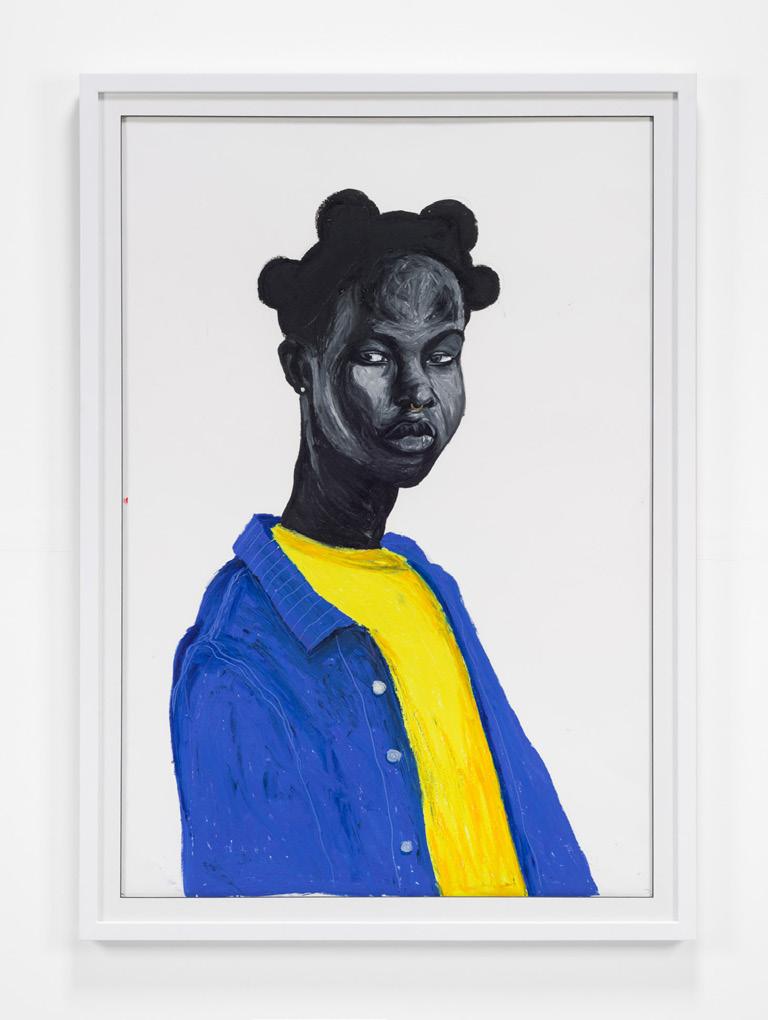
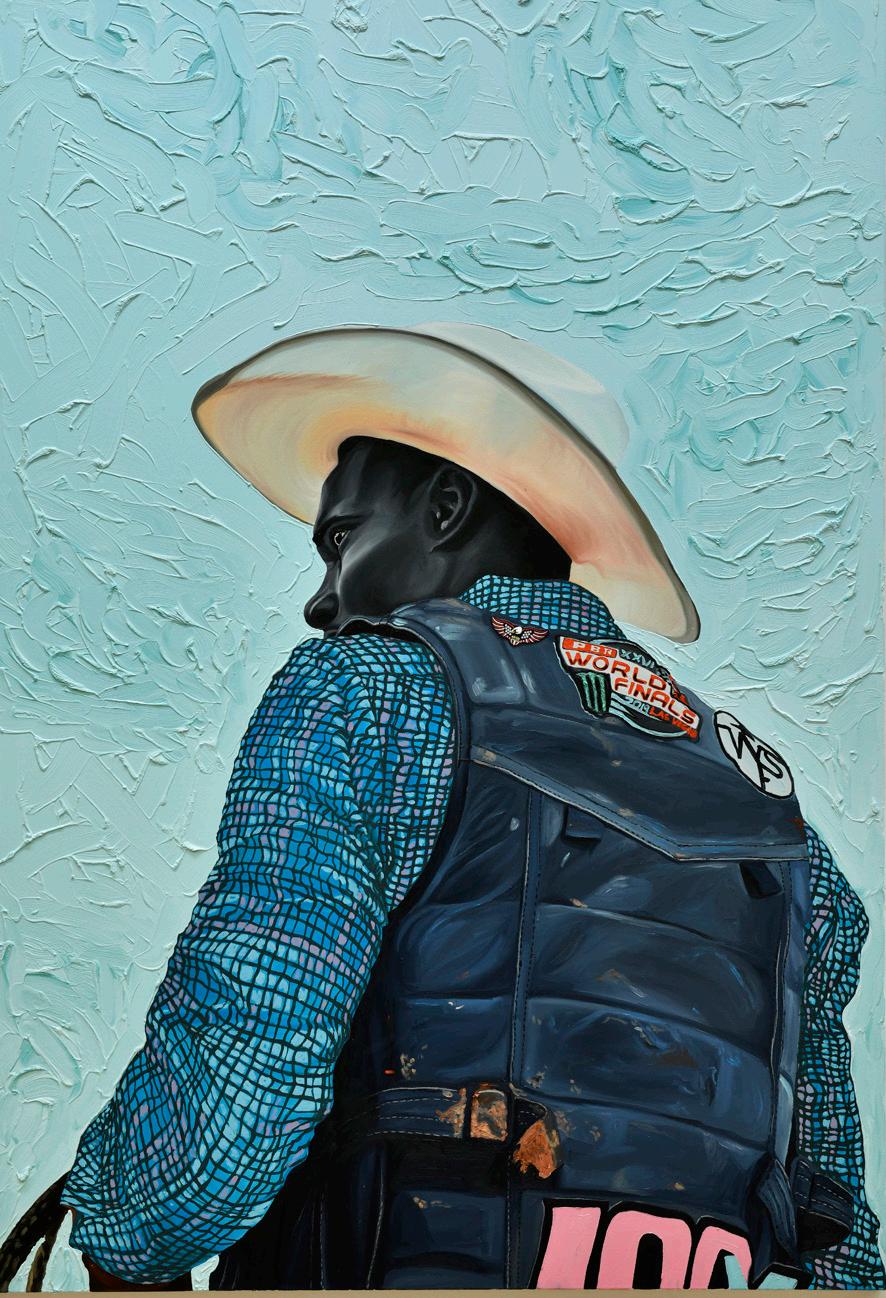

PERSPECTIVES
THROUGH NOVEMBER 13, 2022
Continuing this fall, Perspectives features more than 70 works by local BIPOC (Black, Indigenous, People of Color) photographers made during the Black Lives Matter protests in 2020. Featuring work by artists Emery Barnes, Joseph Blake, Linneas Boland-Godbey, Daveed Jacobo, Mariah Harris, and Byron Merritt, Perspectives turns an important lens on this pivotal moment in our city’s history.
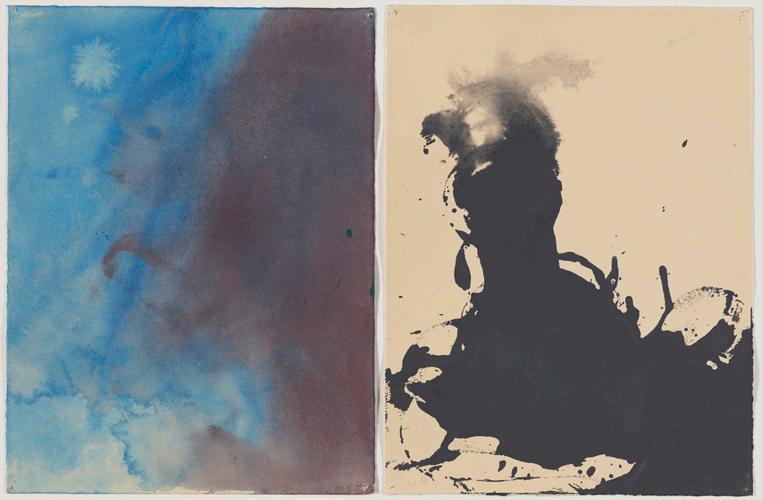
MAKING A MARK:
Contemporary Drawings
THROUGH NOVEMBER 20, 2022
Featuring contemporary works on paper gifted to the Portland Art Museum by noted collectors of drawings Werner H. and Sally Kramarsky, Making a Mark showcases 23 artists whose drawing practices emphasize process, including William Anastasi, Arnold Kemp, Marco Maggi, Allyson Strafella, and Joan Waltemath.

FORCES OF NATURE: Ecology in Japanese Prints
THROUGH DECEMBER 31, 2022
Forces of Nature: Ecology in Japanese Prints explores artistic responses to the environmental forces—some benign, some terrifying—that regulate life on this planet. The works featured in this exhibition consider the ecological relationship between humans and our environment, encompassing mundane moments of daily life, meditative abstractions, and dystopian visions of the future.
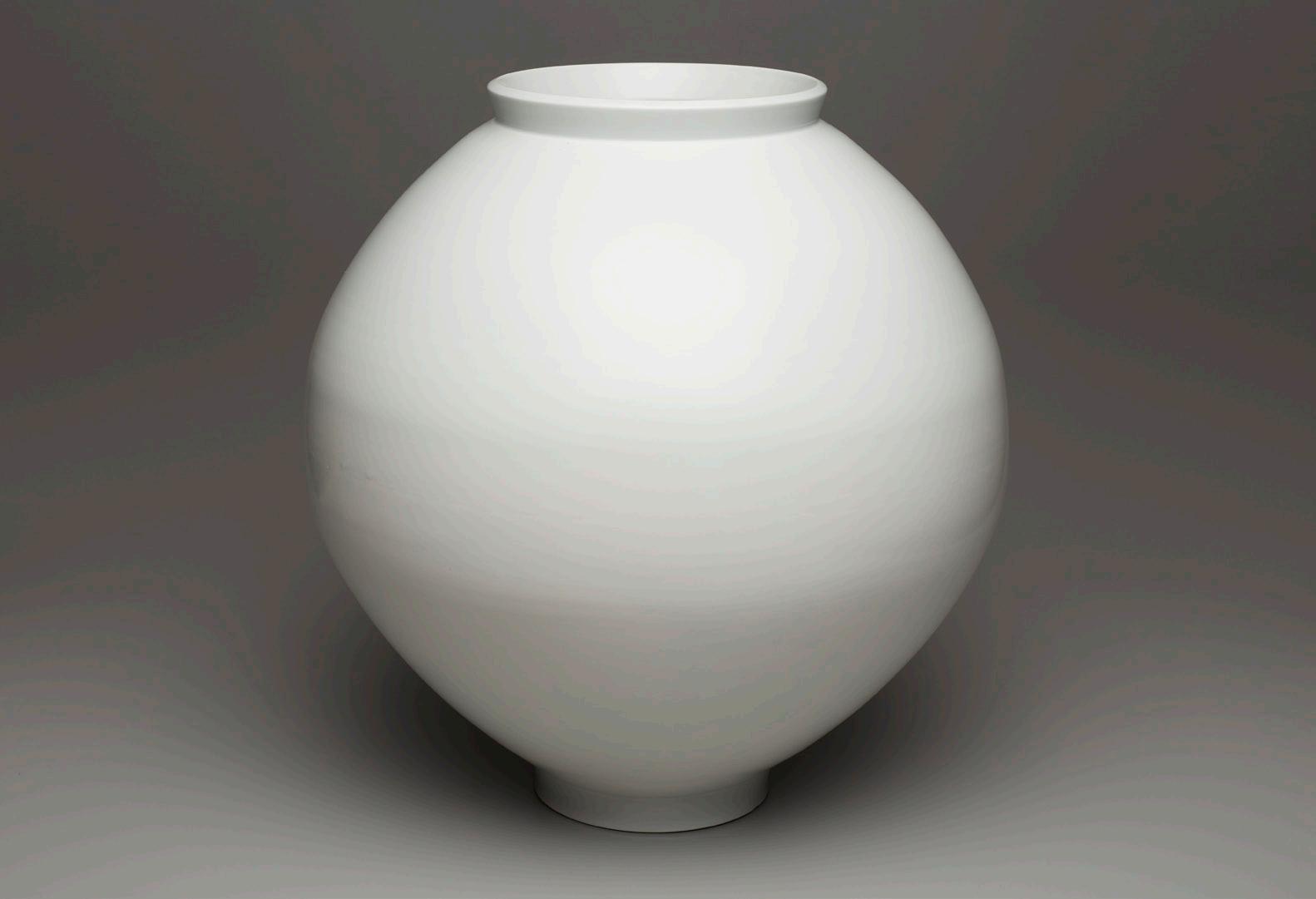
SHADES OF LIGHT
Korean Art from the Collection
THROUGH DECEMBER 31, 2022
Shades of Light brings together ceramics, photography, printmaking, sculpture, and textiles from the Museum’s permanent collection. Linking these objects is the subtle role of light across a broad range of Korean creative practices.

HITO STEYERL: This is the Future
FEBRUARY 11 – MAY 27, 2023
Hito Steyerl creates films, installations, and new media works that focus on the complexities of the digital world, capitalism, and the implications of artificial intelligence (AI) for society. The exhibition features Power Plants, a series of video sculptures recently acquired by the Museum. These vibrant works depict brightly colored, digitally morphing imagery of fictional plants, generated by an AI that predicts their future evolution as healing remedies for contemporary social, political, ecological, and technological ills. This immersive environment includes an augmented-reality experience, exploring an imagined garden taking root in a changing landscape. Organized by the Portland Art Museum and curated by Sara Krajewski, the Robert and Mercedes Eichholz Senior Curator of Modern and Contemporary Art. Supported in part by Exhibition Series Sponsors.

BLACK ARTISTS OF OREGON
JUNE 10 – DECEMBER 3, 2023
Black Artists of Oregon is an exhibition that highlights and celebrates the work of Black artists in and outside of the Museum’s collection. It is the first exhibition of its kind to consider the work of Black artists collectively in Oregon, who are often underrepresented and unacknowledged. Beginning in the 1920s through today, the exhibition captures the African American experience specific to the Pacific Northwest. Among the artists included in the exhibition will be Al Goldsby, Thelma Johnson Streat, Isaka Shamsud-Din, Ralph Chessé, Arvie Smith, Shedrich Williames, Harrison Branch, Robert Colescott, Adriene Cruz, Charlotte Lewis, and Carrie Mae Weems.
Guest curated by artist Intisar Abioto. Supported by the Institute of Museum and Library Services, Meyer Memorial Trust, Terra Foundation for American Art, The Ford Family Foundation, Ed Cauduro Fund of the Oregon Community Foundation, Oregon Heritage Commission, and the Museum’s Artist Fund.

AFRICA FASHION
FALL 2023
In October 2023, the Portland Art Museum will present Africa Fashion, a major exhibition from the Victoria and Albert Museum (V&A) in London that will celebrate the richness and diversity of African creativity, cultures, and histories, using fashion as a catalyst. Spanning iconic mid-20th century to contemporary designs, Africa Fashion will explore the vitality and global impact of a fashion scene as dynamic and varied as the continent itself.
The irresistible creativity, ingenuity, and unstoppable global impact of contemporary African fashions are celebrated in an extensive display of garments, textiles, personal testimonies, photographs, sketches, film, and catwalk footage in this exhibition. Many of the garments hail from the archives of iconic midtwentieth century African designers—Shade Thomas-Fahm, Chris Seydou, Kofi Ansah, and Alphadi. Alongside these are personal insights from influential contemporary African fashion creatives, including Imane Ayissi, IAMISIGO, Moshions, Thebe Magugu, and Sindiso Khumalo, as well as highlights from fashion trends of the day, which are on display for the first time.
Exhibition organized by the Victoria and Albert Museum, London. Curated for Portland by Julia Dolan, Ph.D., The Portland Art Museum’s Minor White Curator of Photography. Supported in part by Exhibition Series Sponsors.





